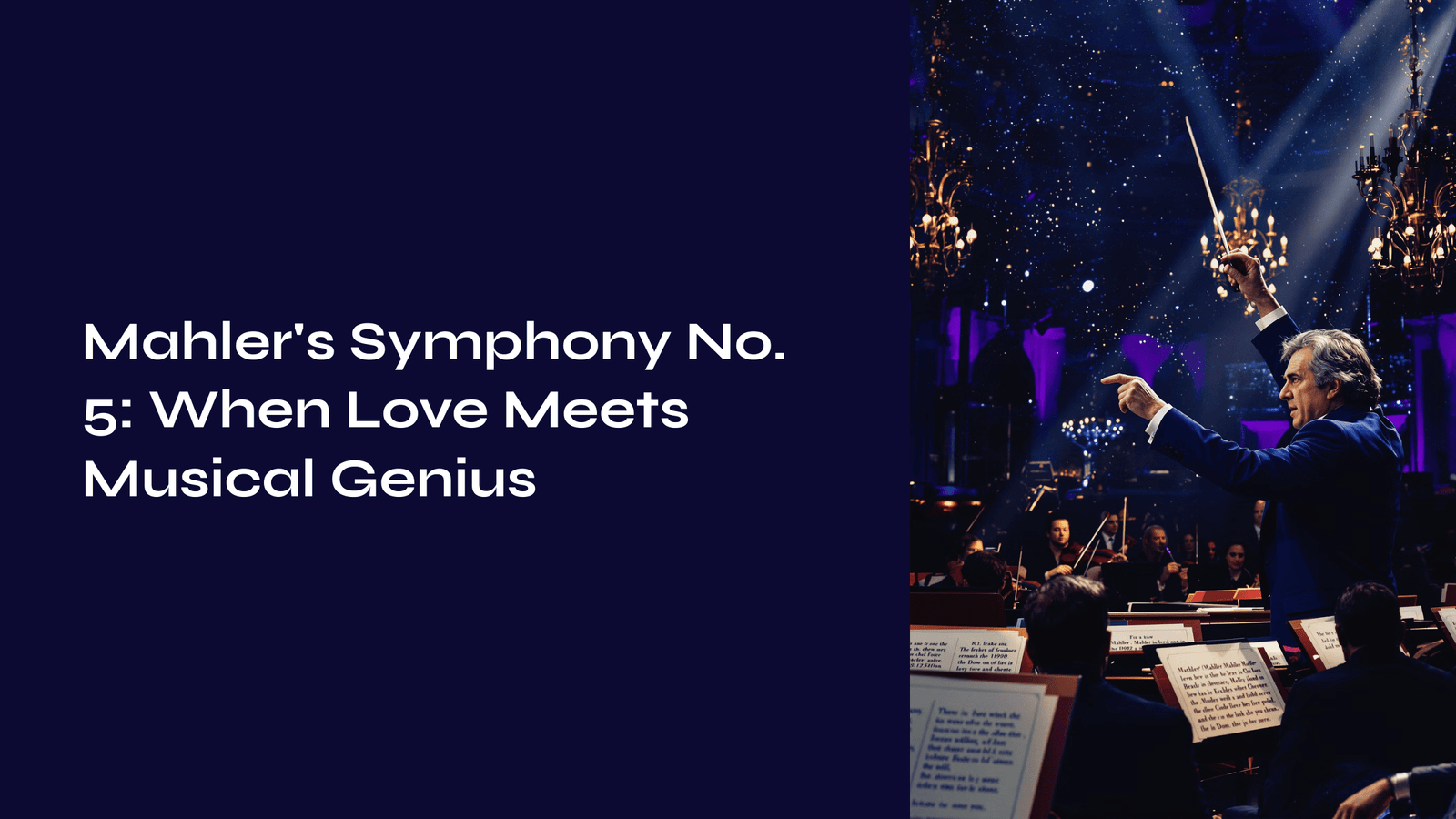Table of Contents

When Music Becomes a Love Letter
Have you ever wondered what it sounds like when a composer falls deeply in love? Imagine sitting in your favorite quiet corner, perhaps with a warm cup of tea, when suddenly you hear those tender opening notes played by strings and harp. The melody seems to whisper secrets directly to your heart, carrying an intimacy so profound that you feel like you’re eavesdropping on a private conversation between two souls. This is exactly what happens when you encounter Gustav Mahler’s Adagietto from his Fifth Symphony – a piece that transforms the concert hall into the most romantic setting imaginable, where music becomes the universal language of love.

A Composer at the Crossroads of Life and Art
Gustav Mahler composed his Symphony No. 5 during 1901-1902, a period that would prove to be one of the most transformative in his life. Working at his summer cottage in Maiernigg, Mahler was experiencing a creative renaissance that coincided perfectly with a life-changing romance. In November 1901, he met Alma Schindler, the captivating daughter of a renowned landscape painter, and their whirlwind courtship became the emotional backdrop for this symphony.
The timeline tells a beautiful story: Mahler began the symphony in November 1901, proposed to Alma in December, and married her in March 1902 – all while crafting what would become one of classical music’s most beloved works. This symphony marked a significant departure from his earlier compositions, representing his first purely instrumental work since his Symphony No. 1, free from vocal elements or programmatic narratives.
When the symphony premiered in Cologne on October 18, 1904, audiences encountered something entirely new in Mahler’s output – a work that spoke through pure musical expression rather than words or explicit storytelling.

A Musical Journey from Darkness to Light
Mahler structured his Fifth Symphony as an emotional odyssey, organizing five movements into three distinct parts that trace a path from despair to triumph.
Part I: The Shadow of Mortality The symphony opens with a haunting funeral march in C-sharp minor, marked to be played “like a funeral procession.” The famous trumpet fanfare that begins this movement deliberately echoes Beethoven’s Fifth Symphony, establishing a connection to classical tradition while forging entirely new territory. The second movement continues this turbulent energy with “stormy movement, with the greatest vehemence,” as if the soul is revolting against fate itself.
Part II: The Dance of Renewal The third movement Scherzo serves as a bridge between darkness and light. Written in D major, it’s marked “strong and not too fast,” presenting a robust, almost rustic dance that suggests life’s resilience and capacity for joy even after profound loss.
Part III: Love’s Triumph Here we encounter the symphony’s most famous movement – the Adagietto – followed by a jubilant finale. This final section represents Mahler’s musical depiction of love conquering all, transforming suffering into transcendent beauty.

The Adagietto: Music’s Most Intimate Confession
The fourth movement, the Adagietto, stands alone as perhaps the most recognizable piece of classical music ever written. Scored only for strings and harp, it creates an “island of calm in the seething tumult of the Fifth Symphony.” In just 103 bars lasting approximately 8-12 minutes, Mahler achieves something miraculous – he distills the essence of romantic love into pure sound.
Willem Mengelberg, Mahler’s close friend and renowned conductor, revealed the movement’s secret: “This Adagietto was Gustav Mahler’s declaration of love to Alma! Both of them told me this!” Imagine Mahler, unable to find adequate words for his overwhelming feelings, instead choosing to speak through the universal language of music.
The performance markings tell the story: “espressivo, seelenvoll” (soulful), “mit innigster Empfindung” (with the most heartfelt sentiment), “mit Wärme” (with warmth). Every instruction guides performers to channel not just technical precision, but genuine emotional vulnerability.

A Personal Encounter with Musical Intimacy
When you listen to the Adagietto, something extraordinary happens. The gentle string melody enters like a whispered confession, so tender that it seems almost too private for public performance. The harp provides delicate punctuation, like soft touches in a lover’s conversation. As the music unfolds, you witness a musical courtship – sometimes hesitant, sometimes passionate, always deeply sincere.
What strikes me most about this movement is its ability to make every listener feel like they’re experiencing something personal. Whether you’re hearing it for the first time or the hundredth, the Adagietto creates a bubble of intimacy that transcends the concert hall setting. It’s music that doesn’t just entertain – it confides in you.
The beauty lies in Mahler’s restraint. After the massive orchestrations of the previous movements, he strips everything down to its emotional essence. No brass, no percussion, no overwhelming climaxes – just the pure voice of strings supported by harp, creating music that speaks directly to the heart.

Discovering Your Own Musical Love Story
To truly appreciate Mahler’s Fifth Symphony, try this approach: listen to the complete work as a single journey, but pay special attention to the emotional transitions between movements. Notice how the funeral march’s despair gradually transforms through the Scherzo’s defiant energy, leading to the Adagietto’s tender revelation, and finally exploding into the finale’s jubilant celebration.
For the Adagietto specifically, find a quiet moment when you won’t be interrupted. Close your eyes and let the music wash over you without trying to analyze it. This isn’t music for the mind – it’s music for the soul. Pay attention to how the melody breathes, how it seems to sigh and soar in turn.
If you’re curious about different interpretations, explore various recordings. Some conductors, following historical tradition, perform the Adagietto more quickly (around 8 minutes), emphasizing its song-like quality. Others stretch it to 12 minutes or more, creating a more meditative experience. Each approach reveals different facets of Mahler’s emotional landscape.

The Eternal Song of Love
Mahler’s Symphony No. 5, and particularly its Adagietto, represents something profound about human nature – our need to express the inexpressible. When words fail to capture the depth of our emotions, music steps in to speak the unspeakable. This symphony doesn’t just tell us about love; it makes us feel love’s transformative power.
More than a century after its composition, the Adagietto continues to serve as humanity’s musical love letter. It has soundtracked countless films, provided solace at memorial services, and created magical moments in concert halls worldwide. Its enduring appeal lies in its fundamental truth – that love, in all its vulnerability and strength, remains the most powerful force in human experience.
In a world that often feels chaotic and disconnected, Mahler’s Fifth reminds us that beauty and love persist. The symphony’s journey from darkness to light mirrors our own human experience, offering hope that even in our darkest moments, transformation and transcendence remain possible. When Mahler wrote his musical love letter to Alma, he unknowingly created a love letter to all of humanity – a reminder that we are capable of creating and experiencing profound beauty.

If You Loved This, Listen to This Next
If you were captivated by Mahler’s tender declaration of love in the Adagietto and its ability to transform profound emotion into transcendent music, you might find yourself equally enchanted by Franz Liszt’s Liebestraum No. 3: When Love Becomes Music – where similar romantic intimacy and poetic sensitivity create a solo piano masterpiece that speaks directly to the heart with every delicate phrase.
Both works reveal how composers can distill the essence of love into pure musical expression, creating timeless pieces that continue to move listeners across generations with their emotional honesty and exquisite beauty.



